From my point of view, one of the most significant drawbacks of listening to recorded music at home is the compression of the dynamic range, which results in insufficient "contrast" compared to what is heard at a live symphonic concert. The equipment may play smoothly, but listening to it can be boring. Live sound is not always smooth, and sometimes it requires some effort to perceive, but it certainly cannot be called boring.
The changes in volume in a concert hall can take your breath away.
Can realistic sound like this be achieved with headphones?
After lengthy experiments with various amplifier schemes and PCB topologies, I believe I have figured out how to create a device that does not "steal" dynamics.
The main points are as follows:
1. It must be a solid-state amplifier because only this type can provide low output impedance and low harmonic and intermodulation distortion.
2. The amplifier circuit should operate in class A with a large and almost constant bias current, excluding modulation of the device's power consumption by the musical signal.
3. High output power is not required because typical headphones have a sensitivity of about 100dB/1mW.
4. High dynamic linearity can be achieved with a topology that makes the amplifier immune to external high-frequency electromagnetic interference, both at the input and output and in the power supply circuits. This is often neglected, but over the past 30 years, the intensity of external electromagnetic fields in large cities and the pollution of the power grid has increased thousands of times (cell phones, Wi-Fi, SMPS, energy-saving light bulbs, etc.). Simple solutions that worked well in old devices no longer work.
In my device, I used a custom CNC-milled aluminum enclosure. If you put a cell phone inside such an enclosure and call it, the call will not go through because the enclosure is capable of completely blocking incoming and outgoing radio waves. Ordinary enclosures consisting of separate panels connected by screws do not have this ability.
The listening experience of the device revealed the following distinguishing features:
Tech specs:
Input connector type: 2xRCA unbalanced
Output connector type: stereo 6.5 mm
Input impedance: 10 kOhm
Output impedance: <0.8 Ohm
Frequency response: 5-30000 Hz (-3db)
Gain: 10.8 dB
Channel imbalance: <0.2dB
Max output power: 200mW at 32 Ohm
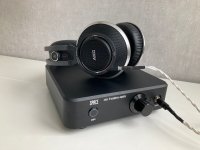
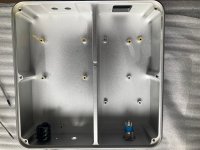
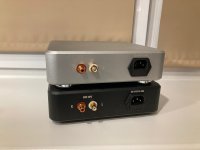
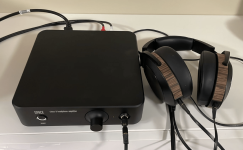
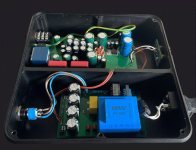
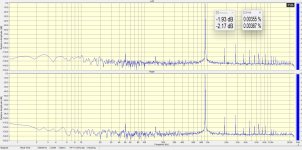
The changes in volume in a concert hall can take your breath away.
Can realistic sound like this be achieved with headphones?
After lengthy experiments with various amplifier schemes and PCB topologies, I believe I have figured out how to create a device that does not "steal" dynamics.
The main points are as follows:
1. It must be a solid-state amplifier because only this type can provide low output impedance and low harmonic and intermodulation distortion.
2. The amplifier circuit should operate in class A with a large and almost constant bias current, excluding modulation of the device's power consumption by the musical signal.
3. High output power is not required because typical headphones have a sensitivity of about 100dB/1mW.
4. High dynamic linearity can be achieved with a topology that makes the amplifier immune to external high-frequency electromagnetic interference, both at the input and output and in the power supply circuits. This is often neglected, but over the past 30 years, the intensity of external electromagnetic fields in large cities and the pollution of the power grid has increased thousands of times (cell phones, Wi-Fi, SMPS, energy-saving light bulbs, etc.). Simple solutions that worked well in old devices no longer work.
In my device, I used a custom CNC-milled aluminum enclosure. If you put a cell phone inside such an enclosure and call it, the call will not go through because the enclosure is capable of completely blocking incoming and outgoing radio waves. Ordinary enclosures consisting of separate panels connected by screws do not have this ability.
The listening experience of the device revealed the following distinguishing features:
- At first, the sound may seem uncomfortable, and adaptation is required.
- After adaptation, the amplifier encourages increasing the volume more and more. The most exciting sound, in my opinion, is achieved at SPL above 90dB.
Tech specs:
Input connector type: 2xRCA unbalanced
Output connector type: stereo 6.5 mm
Input impedance: 10 kOhm
Output impedance: <0.8 Ohm
Frequency response: 5-30000 Hz (-3db)
Gain: 10.8 dB
Channel imbalance: <0.2dB
Max output power: 200mW at 32 Ohm






OK Skippy, is there a circuit or should this be a preamble in the Vendors Forum ?